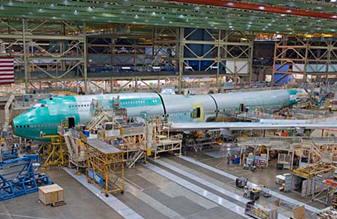|
|||||||||||
|
|
|
|||
|
By Jim Douglas |
||||
 |
October 16, 2010 -
Boeing moved closer this week toward completing assembly of the first
747-8 Intercontinental as mechanics in
The 747-8 fuselage
is 250 feet 2 inches (76.3 meters) long, which is 18 feet 4 inches (5.6
meters) longer than the 747-400. The stretch provides space for 51
additional seats to accommodate 467 passengers in a typical three-class
configuration and offers 26 percent more cargo volume. "Final body join is an important milestone for the 747 program," said Pat Shanahan, vice president and general manager of Airplane Programs in Boeing Commercial Airplanes. |
|||
|
|
||||
|
"It is a major step toward completing the structural integration and building out our all-new interior. We now have the first real look at the size and distinctive shape of the 747-8 Intercontinental. This is going to be a superb airplane for our customers both from an aesthetic and a performance perspective."
The 747-8 is the
new high-capacity 747 that will give airlines the lowest operating costs
and best economics of any large airplane while providing enhanced
environmental performance. The airplane also features a 787
Dreamliner-inspired interior that will offer passengers a greater
feeling of space and comfort.
The passenger
version, named 747-8 Intercontinental or 747-8I was launched on November
14, 2005. The aircraft will be capable of carrying up to 467 passengers
in a 3-class configuration over 8,000 nmi (15,000 km) at Mach 0.855. The
747-8I will carry 51 more passengers and two more freight pallets with
26% more cargo volume than the 747-400. Despite initial plans for a
shorter stretch than the freighter model, the two variants will be the
same length, increasing passenger capacity and allowing easier
modification of the 747-8I to freighter use. The upper deck will be lengthened on the -8I. New engine technology and aerodynamic modifications will allow longer range. Boeing has stated the 747-8I will be quieter than the 747-400, 16% more fuel-efficient than the -400 model, offer airlines trip costs that are nearly equivalent with its predecessor's, and seat-mile costs 13% lower than the -400's. |
||||
|
For the 747-8,
Boeing has proposed some changes to the interior layout of the aircraft.
Most noticeable will be the curved stairway to the upper deck and a more
spacious main passenger entrance. The 747-8's main cabin uses an
interior similar to that of the 787. Overhead bins are curved, and the
center row is designed to look as though it is attached to the curved
ceiling, rather than integrated into the ceiling's curve like on the
777.
The windows will
also be of similar size to the type used on the 777, which are 8% larger
than those on the current 747-400s. The 747-8 will feature a new
solid-state light-emitting diode (LED) lighting system, which can create
mood lighting. LED technology also offers improved reliability and lower
maintenance costs.
Further down the
aircraft, it has been proposed to place cabin-accessible facilities in
the "crown" area, the space above the passenger cabin, currently used
for air-conditioning ducts and wiring. The wiring and ducts will be
moved to the side to create extra space; as a consequence, this area
will not have windows. The added space can be used for galleys and crew
rest areas, freeing up main deck space for additional passenger seating.
During the initial
747-8 marketing phase, Boeing also proposed creating a
revenue-generating "SkyLoft" passenger facility in the crown space. This
facility would include "SkySuites", small individual compartments with
sliding doors or curtains, featuring beds, seating, and entertainment or
business equipment. A common lounge area could also be provided. Boeing
also proposed smaller, more modest "SkyBunks".
Access to the
crown area would be via a separate stairway at the rear of the aircraft.
Passengers using the SkySuites, sold at a premium price, would sit in
regular economy class seats for take-off and landing, and move to the
crown area during flight. However, pricing feasibility studies found the
SkyLoft concept difficult to justify. In 2007, Boeing dropped the
SkyLoft concept in favor of upper-deck galley storage options, which
were favored by the airlines. Outfitting the crown space for sleeping
remains an option on VIP aircraft.
The first order
for the 747-8 Intercontinental was placed by an undisclosed VIP customer
in May 2006, widely believed to be a Middle Eastern head of state.
Lufthansa became the first airline to order the 747-8 Intercontinental
on December 6, 2006. In December 2009, Korean Air announced the order of
five 747-8Is. Boeing announced on May 8, 2010, that the company had
begun final assembly of the first 747-8I. Boeing stated firm configuration for the -8I was reached in November 2007. Major assembly of the -8I began on May 8, 2010. Two 747-8I aircraft are planned to take part in the 747-8I flight test program, the first destined for a VIP customer and the second for Lufthansa. First delivery of the 747-8I is planned for the fourth quarter of 2011. |
|
|
| Other News Stories |
| ?AvStop
Online Magazine
Contact
Us
Return To News
|
|


